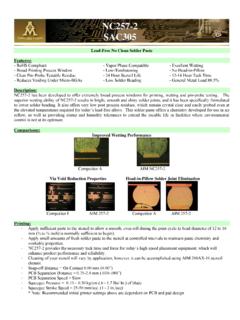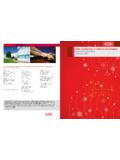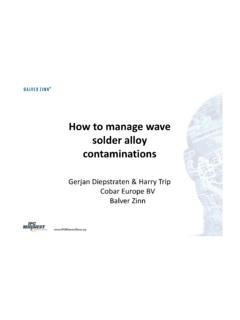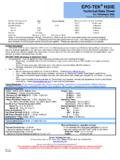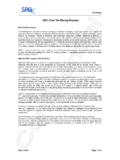Transcription of Project Leader: Author(s): Science Group
1 Harpur Hill, Buxton Derbyshire, SK17 9JN. T: +44 (0)1298 218000. F: +44 (0)1298 218590. W: Hand soldering - Summary of Information HSL/2006/58. Project Leader: Ian Pengelly Author(s): Ian Pengelly Science Group : Environmental Sciences Crown copyright (2006). CONTENTS. 1 1. 2 2. 3 solder PRODUCTS .. 3. Tin/Lead Solders .. 3. Lead-Free Solders .. 4. 4 7. 5 8. 6 ANNEX 1: DATABASE OF solder 10. ii EXECUTIVE SUMMARY. Objectives This report was compiled following a request from Andrew Garrod of CHSD 3, Bootle for background information on soldering for an HSE Project on rosin-cored solder fume.
2 This Project only covers hand soldering and not activities such as wave soldering , plumbing flux, investment casting waxes, hot melt glues, resins, sealing waxes or rosin manufacture. Main Findings A wide range of cored solder wires are available from a large number of suppliers. The various solder wire products can be divided into a relatively small number of groups based on their metal (lead-based or lead-free) and flux (rosin-based, modified rosin, water soluble or rosin-free) composition. In the past lead-based solders have dominated the market, but this is set to change with the implementation of EC RoHS (Restriction on use of Hazardous Substances) and WEEE (Waste Electrical and Electronic Equipment) directives.
3 A variety of rosin-free solder products is available, but, for various reasons, the take-up of these products is still relatively low. Confusion still exists over the definition of rosin-free , in particular as to whether fluxes based on modified rosin and which may still generate airborne resin acids when heated, should really be regarded as rosin-free . The move to rosin-free products is subject to many of the same concerns as the move to lead- free, namely quality, durability, etc. Scrutiny of most of the MSDS obtained for rosin-free solders has shown that they contain little or no information on either the compounds present in the flux or those likely to be generated on heating.
4 This lack of product safety information makes a proper risk assessment difficult and provides a major disincentive to their use. Despite some potentially harmful properties, many of the components identified in the few rosin-free products examined at HSL do not have occupational exposure limits. In addition, there is little or no occupational exposure information related to the use of such products. There are no set methods for monitoring of fume generated by rosin-free products (other than MDHS 83 to confirm that no resin acids are present in the fume). Recommendations If proper risk asssessments are to be undertaken, the standard of product safety information for many solder wire products needs to be improved, particularly in the cases of those products containing rosin-free fluxes.
5 Iii 1 INTRODUCTION. This report was compiled following a request from Andrew Garrod of CHSD 3, Bootle for background information on soldering for an HSE Project on rosin-cored solder fume. This Project only covers hand soldering and not activities such as wave soldering , plumbing flux, investment casting waxes, hot melt glues, resins, sealing waxes or rosin manufacture. The report provides a summary of information covering the following issues:- Who supplies solder into the UK market, and how is the market moving. What solders do they supply (including lead-free solders). Which of these claim to be rosin-free, and which really are rosin-free.
6 Is it possible to acquire safety current safety data sheets for subsequent scrutiny/analysis. Can a mendacity tool' be created for HSE inspectors, to detect when an employer is trying to deceive HSE about the practicability of substitution. 1. 2 SUPPLIERS. A wide range of different cored solder wires can be obtained from a large number of suppliers. A search of the Internet located in excess of a hundred products, a figure which rapidly multiplies when all the combinations of metal and flux composition and/or content are taken into account. A brief summary of the various products and companies located is contained in Annex 1.
7 This list probably covers most of the major suppliers, but it is certainly not an exhaustive lists of all possible suppliers of solder wire products. 2. 3 solder PRODUCTS. Cored solder wires, as used in most hand soldering , comprises an alloy wire containing one or more flux cores. During soldering the metal wire is melted to join other metal surfaces whilst the flux reacts with, and removes, compounds from the surface of the joint, to improve the flow of the solder and prevent oxidation. The soldering process generates solder flux fume, the composition of which is dependent on the flux type present.
8 solder flux fume may also be generated from flux residues during desoldering or recycling operations. Although there is a huge number of products available, the majority of cored solder wires fall into one of the following groups. TIN/LEAD SOLDERS. These are the traditional solder wires and generally have a metal content of around 60% tin and 40% lead. These solders generally contain a flux core comprised of one of the following:- Rosin-Based flux These are the classic rosin (colophony) solders, typically containing between 1 and 3% w/w of rosin-based flux. This type of flux tends to have a distinct yellow coloration and to leave a hard residue on the work piece after soldering .
9 This residue can be left in situ and hence these products are often referred to as No Clean solders. The resin acid components present are generally those containing either two (abietic/pimaric and isomers) or three (dehydroabietic). carbon-carbon double bonds. Fume generated during heating of rosin cored solders forms the basis of current exposure limits. Activators, typically halides, are often added to the flux. These activators increase the reactive properties (or activity) of the flux. This allows soldering of more difficult metals or, alternatively, to reduce the amount of flux in the solder .
10 Activated fluxes can be divided into the following sub-groups according to their degree of activation:- RMA Rosin (Mildly Activated);. RA Rosin (Activated);. RSA Rosin (Super Activated). Modified Rosin Fluxes Modified rosin solders also typically contain between 1 and 3% of flux. Like rosin based products, they are often described as No Clean solders, with the main difference being that the residue left behind by modified rosin fluxes is generally colourless. and this is often cited as the main reason for using these products. Analysis of modified rosin fluxes at HSL have shown that they generally contains resin acid components which, compared to those unmodified rosin fluxes, have undergone a hydrogenation/dehydrogenation.










